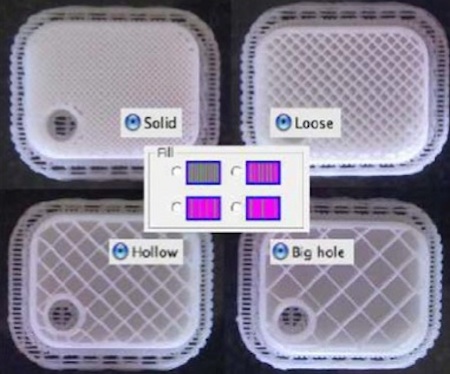
We’ve been reading more about this week’s legal action by Stratasys against personal 3D printer marketer Afinia, who are alleged to have violated several of Stratasys’ patents.
We’ve obtained a copy of the “Complaint for Patent Infringement” filed in the United States District Court, District of Minnesota (where Stratasys’ HQ is located, and, totally coincidentally, Afinia’s too). In the complaint, Stratasys claims Microboards (the company behind the Afinia brand) has violated four specific patents:
U.S. Patent No 5,653,925 “METHOD FOR CONTROLLED POROSITY THREE-DIMENSIONAL MODELING”. This patent:
relates to methods for controlling the porosity of objects through, among other things, adjusting the rate of deposition of material to create gaps as the object is built up layer by layer.
In other words, selecting the “fill density” from a pre-determined list of choices.
U.S. Patent No. 5,866,058 “METHOD FOR RAPID PROTOTYPING OF SOLID MODELS”. This patent includes:
methods for controlling the solidification of extruded materials in layers by, among other things, maintaining a build environment in the vicinity where material is deposited at a temperature above a solidification temperature. The claimed methods tend to reduce the impact of curl deformation due to internal stresses created in the object during solidification.
This is interpreted by Stratasys as the Afinia’s heated bed.
U.S. Patent No. 6,004,124 “THIN-WALL TUBE LIQUIFIER”. This patent:
relates to an apparatus for controlling the temperature of extrudable material in the liquifier of the extruder through the use of a novel thin-wall tube construction in the liquifier.
In other words, Afinia’s extruder heater block appears to use this technique.
U.S. Patent No. 8,349,239 “SEAM CONCEALMENT FOR THREE-DIMENSIONAL MODELS”. This patent relates to:
methods for concealing layer seams by generating a contour tool path for a layer of extruded material, where the contour tool path comprises a start point, a stop point, and a path between the start point and the stop point that seals a perimeter of a layer. For example, the start and/or stop points may be located within the interior of a perimeter of the contour tool path
This is a technique used by not only Afinia but other filament 3D printers as well.
We will continue our analysis in a future post.

